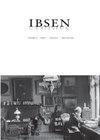The Platonic Intertext in Ibsen’s Hedda Gabler and Little Eyolf
IF 0.1
0 THEATER
引用次数: 0
Abstract
If we place Hedda Gabler within a broad intertextual scope of Plato’s Symposium, as proposed by Kristin Boyce (2018) in her analysis, then Ibsen’s play Little Eyolf could be examined as a subsequent transcript of this famous philosophical dialogue on love. Little Eyolf might be viewed as an appendix or a sequel to Hedda Gabler, a piece stemming from the remains of its motif—as though it rose from the ashes in Hedda’s fireplace or sprang from the pieces of paper out of which Tesman and Thea hope to compile a new book in the final scene of the play. In Little Eyolf, the play Ibsen wrote four years after Hedda Gabler, he continues to evolve Plato’s metaphor of giving birth to a book like giving birth to a child. Little Eyolf is a play about a book that never managed to mature, about a child who never grew up, about people striving to grow fully as people. As in the play Hedda Gabler, in which missing books and unborn children forever remain shrouded by darkness—either hidden in their mother’s womb, trapped in the scholar’s head, or burnt in the black rectangle of a fireplace—in Little Eyolf the hypothesis remains unfinished and the child is lost. As noted by Ernst Robert Curtius in his study European Literature and the Latin Middle Ages, “the concept of the book as a child [... ] goes back to Plato’s doctrine of Eros” (Curtius 2013, 132). In Plato’s Symposium—in the part where Socrates decides to convey what Diotima taught him about the subject of love—love is defined as “giving birth in the beautiful, in respect of body and易卜生《海达·盖博勒与小埃尔夫》中的柏拉图互文
如果我们把Hedda Gabler放在柏拉图的《会篇》的互文范围内,正如Kristin Boyce(2018)在她的分析中提出的那样,那么易卜生的戏剧《小Eyolf》可以作为这一著名的关于爱的哲学对话的后续文本来研究。《小埃尔夫》可以被看作是《海达·盖博勒》的附录或续集,是源于其主题残余的一部作品——仿佛它从海达壁炉里的灰烬中升起,或者从泰斯曼和西娅希望在戏剧的最后一幕编写一本新书的那张纸上冒出来。易卜生在《海达·盖博勒》(Hedda Gabler)之后四年创作的戏剧《小埃尔夫》(Little Eyolf)中,他继续发展了柏拉图的比喻,即写书就像生孩子一样。《小埃尔夫》是一部关于一本从未成熟的书,一个从未长大的孩子,一个努力成长为完整的人的戏剧。就像在戏剧《海达·盖博勒》中,丢失的书和未出生的孩子永远被黑暗笼罩着——要么藏在母亲的子宫里,要么困在学者的脑海里,要么被烧在壁炉的黑色矩形里——在《小埃尔夫》中,这个假设没有完成,孩子也不见了。正如恩斯特·罗伯特·柯提乌斯在他的《欧洲文学与拉丁中世纪》一书中所指出的那样,“孩子对书的概念……可以追溯到柏拉图的爱神学说”(Curtius 2013, 132)。在柏拉图的《座谈会》中——在苏格拉底决定传达狄奥提玛教给他的关于爱的主题的部分——爱被定义为“在美丽中生育,在身体和
本文章由计算机程序翻译,如有差异,请以英文原文为准。
求助全文
约1分钟内获得全文
求助全文

 求助内容:
求助内容: 应助结果提醒方式:
应助结果提醒方式:


